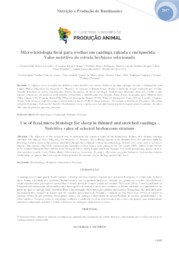Micro-histologia fecal para ovelhas em caatinga raleada e enriquecida; Valor nutritivo do estrato herbáceo selecionado.
Micro-histologia fecal para ovelhas em caatinga raleada e enriquecida; Valor nutritivo do estrato herbáceo selecionado.
Author(s): CARVALHO, E. K. R.; ARAUJO, A. R.; RODRIGUEZ, N. M.; ROGERIO, M. C. P.; BRANDAO, I. S.; SANTOS, S. A.; SILVA, H. P.
Summary: Resumo: O objetivo desta pesquisa foi definir o valor nutritivo do estrato herbáceo de uma caatinga raleada e enriquecida com Capim Massai (Megathyrsus maximus cv. Massai). As espécies coletadas foram obtidas a partir da seleção realizada por ovelhas Somalis brasileira no pasto, identificadas através da técnica de micro-histologia fecal. Foram utilizadas dezesseis ovelhas como animais-referência. As espécies efetivamente consumidas e identificadas nas lâminas fecais foram analisadas para: Matéria Seca (MS); Cinzas (CZ); Proteína Bruta (PB); Fibra em Detergente Neutro (FDN); Fibra em Detergente Ácido (FDA); Lignina e Taninos Totais. Vale destacar, espécies como o Alternanthera tenella Colla (Cabeça branca), Alternanthera brasiliana (Ervanço), Merremia aegyptia (Jetirana), Stylosanthes humilis (Estilosante), como espécies que tem um bom potencial forrageiro para os animais, devido o alto valor de proteína que elas possuem. [Use of fecal micro histology for sheep in thinned and enriched caatinga; Nutritive value of selected herbaceous stratum]. Abstract: The objective of this research was to determine the nutritive value of the herbaceous stratum of a thinned caatinga enriched with Massai Grass (Megathyrsus maximus cv. Massai). The collected species were obtained from the selection made by Brazilian Somalis sheep in the pasture, identified through the technique of fecal microhistology. Sixteen ewes were used as reference animals. The species effectively consumed and identified in fecal blades were analyzed for: Dry matter (DM); Ashes; Crude Protein (CP); Neutral Detergent Fiber (NDF); Acid Detergent Fiber (ADF); Lignin and Total Tannins. It is worth mentioning, species such as Alternanthera tenella Colla (White Head), Alternanthera brasiliana (Ervanço), Merremia aegyptia (Jetirana), Stylosanthes humilis (Estilosante, as species that have a good fodder potential for animals, due to the high protein they have.
Publication year: 2017
Types of publication: Paper in annals and proceedings
Unit: Embrapa Goats & Sheep
Keywords: Alimento Para Animal, Alternanthera brasiliana, Animal feeding, Animal nutrition, Aristida longiseta, Brazil, Bromatologia, Composição Botânica, Forage grasses, Gramínea Forrageira, Megathyrsus maximus, Merremia aegyptia, Nutrição Animal, Ovino, Oxalis divaricata, Ruminant nutrition, Semiarid soils, Sesuvium portulacastrum, Sheep feeding, Stylosanthes Humilis
Related content
Observation
Some of Embrapa's publications are published as ePub files. To read them, use or download one of the following free software options to your computer or mobile device. Android: Google Play Books; IOS: iBooks; Windows and Linux: Calibre.
Access other publications
Access the Agricultural Research Database (BDPA) to consult Embrapa's full library collection and records.
Visit Embrapa Bookstore to purchase books and other publications sold by Embrapa.

